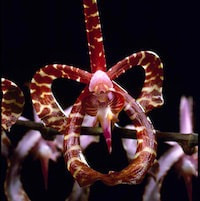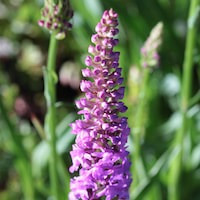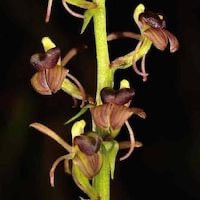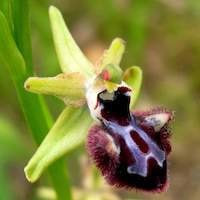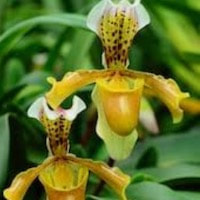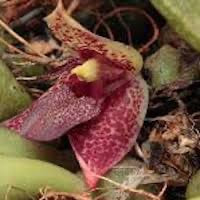WOR3- Women's Oriental 3 - Too hot to handle
|
Native Singaporean Orchid notes: Bulbophyllum Praetervisum
Bulbophyllum praetervisum, an orchid known for its exquisite scent, is a crucial element in fragrances like Oriental 3 (Women) for Team Building Perfume workshops. Despite its aromatic appeal, it's classified as Critically Endangered and locally rare by Singapore's Nparks. To safeguard its future, Nparks initiated a Species Recovery Programme in 2017. This orchid's physical beauty includes glossy, thick petals and a solitary flower per stem. Its spicy fragrance evokes warmth and allure, enriching perfumes and raising awareness about conservation efforts essential for preserving this rare botanical gem.
|
Therapeutic Orchid notes:
|
Arachnis moschifera
Arachnis moschifera, known as "Ueang maeng mum" in Thai, is a prominent orchid species cherished for its powerful musk-like fragrance. Found in Malaysia, Thailand, Sumatra, and Borneo, it thrives in Southeast Asia's tropical climates. Despite not being native to Singapore, a natural hybrid named A. maingayi was discovered by Mr. Cedric Errol Carr in the mangroves of Pulau Seletar, resulting from a cross between A. flos-aeris and A. hookeriana. This orchid's intense scent resembles musk, making it prized in the fragrance industry and valued for traditional medicinal uses among Sarawak's Ibans, who use its sap for toothache relief. The presence of A. maingayi exemplifies orchids' adaptability and resilience, enriching Southeast Asia's biodiversity and cultural heritage. |
|
Gymnadenia conopsea (L.) R.Br.
Gymnadenia conopsea (L.) R.Br., known as "shou shen" (hand ginseng), "Shouzhangshen" (Palm ginseng), "Foshoushen" (Buddha hand ginseng), and "Zhangshen" (palm ginseng) in Chinese, and "Tegata-chidori" in Japanese, thrives in diverse habitats from open forests to rocky slopes across Japan, Korea, Russia, and Europe. In traditional Chinese medicine, it's highly esteemed akin to ginseng for kidney health, stopping bleeding, and restoring vitality during illness. Its stem treats ailments like weak lungs, impotence, and chronic conditions such as hepatitis. Phytochemical studies highlight its tubers' compounds for potential anti-allergic and lung fibrosis-preventing effects, suggesting broader medicinal uses and ecological importance. |
|
Liparis odorata (Willd.) Lindl. Syn. Liparis paradoxa (Lindl.) Rchb.f.
Liparis odorata, known as "Xianghuayangersuan" in Chinese and "Erxiantao" in Chinese medicine, is a terrestrial herb notable for its flowering season varying across regions like India, Bhutan, Nepal, and China. It's used in traditional medicine for treating conditions such as elephantiasis, where it's documented in the Hortus Indicus Malabaricus. In Karnataka, its pseudobulb treats fever and edema, while its roots' juice aids burns and inflammation. In China, it addresses flu symptoms, neuritis, leucorrhoea, and more, known for dispelling "wind" and removing "dampness" in Chinese medicine, prepared as a decoction from dried pseudobulbs. |
|
Ophrys sphegodes Mill.
Ophrys sphegodes Mill., commonly known as the Early spider orchid, is a captivating orchid species celebrated for its distinct scent and clever reproductive strategy. Native to western and southern Europe extending to northern Iran, it thrives in chalky soils of meadows, pastures, and forest clearings, particularly flourishing in Italy at altitudes of 100 to 750 meters. This orchid mimics the scent of female insects like bees and wasps to attract males for pollination, a tactic known as sexual deception. Its tubers are also valued as a source of salep, historically used in traditional medicine and cooking for its perceived medicinal benefits, although unsustainable harvesting poses conservation challenges for these unique plants. |
|
Paphiopedilum parishii (Rchb f.) Pfitzer
Paphiopedilum parishii (Rchb f.) Pfitzer, known as "spiral tongued orchid," "pocket orchid," "mottled leaf orchid," or "piaodaidou lan" in Chinese, and "qianlinglan" in Chinese medicine, is a unique orchid species valued for its medicinal properties. Found in montane forests across Thailand, Laos, Myanmar, Yunnan, and Assam, it thrives in shady, humid environments at elevations of 1200 to 2200 meters. In traditional Chinese medicine, the entire plant is used for its antipyretic and detoxifying effects, aiding conditions like anxiety, skin rashes, kidney health, and dry cough. Its distinctive appearance with greenish-yellow petals and dark purple spots adds to its allure, reflecting its cultural and medicinal significance. |
|
Trias disciflora (Rolfe) Rolfe
Trias disciflora (Rolfe) Rolfe, known as "Ma tak kok" in Thai, is a small epiphytic orchid native to northeastern Thailand. Epiphytic plants grow on other plants or objects for support rather than in the ground. While specific details on its scent are not available, orchids often produce unique fragrances to attract pollinators like insects or animals. In traditional Thai medicine, Trias disciflora is used as a tonic, believed to invigorate and strengthen the body for better overall health. Scientific research is needed to confirm its medicinal properties and ensure safety, although traditional uses highlight its potential value in herbal remedies and cultural practices. |
Other scent note
Guarana coffee, base notes of white musk, vetiver, Hyrax, Ambertone, Lorenox, spice mix, Banana leaf
Scentopia Library Reference ingredient
Butter fruit - Sentosa's fragrant plant - Check details at Scentopia's scent library
Download the guided mediation that works best with this Orchid fragrance oil
| women_oriental_essential_oil_orchi_00003.mp3 | |
| File Size: | 29744 kb |
| File Type: | mp3 |

